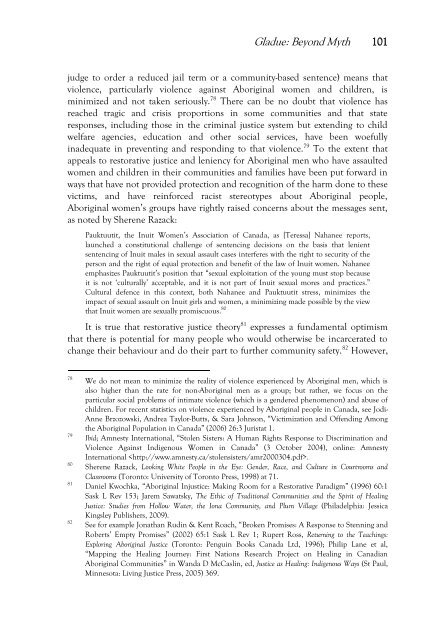Download PDF - Robson Hall Faculty of Law
Download PDF - Robson Hall Faculty of Law
Download PDF - Robson Hall Faculty of Law
You also want an ePaper? Increase the reach of your titles
YUMPU automatically turns print PDFs into web optimized ePapers that Google loves.
Gladue: Beyond Myth 101<br />
judge to order a reduced jail term or a community-based sentence) means that<br />
violence, particularly violence against Aboriginal women and children, is<br />
minimized and not taken seriously. 78 There can be no doubt that violence has<br />
reached tragic and crisis proportions in some communities and that state<br />
responses, including those in the criminal justice system but extending to child<br />
welfare agencies, education and other social services, have been woefully<br />
inadequate in preventing and responding to that violence. 79 To the extent that<br />
appeals to restorative justice and leniency for Aboriginal men who have assaulted<br />
women and children in their communities and families have been put forward in<br />
ways that have not provided protection and recognition <strong>of</strong> the harm done to these<br />
victims, and have reinforced racist stereotypes about Aboriginal people,<br />
Aboriginal women’s groups have rightly raised concerns about the messages sent,<br />
as noted by Sherene Razack:<br />
Pauktuutit, the Inuit Women’s Association <strong>of</strong> Canada, as [Teressa] Nahanee reports,<br />
launched a constitutional challenge <strong>of</strong> sentencing decisions on the basis that lenient<br />
sentencing <strong>of</strong> Inuit males in sexual assault cases interferes with the right to security <strong>of</strong> the<br />
person and the right <strong>of</strong> equal protection and benefit <strong>of</strong> the law <strong>of</strong> Inuit women. Nahanee<br />
emphasizes Pauktuutit’s position that “sexual exploitation <strong>of</strong> the young must stop because<br />
it is not ‘culturally’ acceptable, and it is not part <strong>of</strong> Inuit sexual mores and practices.”<br />
Cultural defence in this context, both Nahanee and Pauktuutit stress, minimizes the<br />
impact <strong>of</strong> sexual assault on Inuit girls and women, a minimizing made possible by the view<br />
that Inuit women are sexually promiscuous. 80<br />
It is true that restorative justice theory 81 expresses a fundamental optimism<br />
that there is potential for many people who would otherwise be incarcerated to<br />
change their behaviour and do their part to further community safety. 82 However,<br />
78<br />
79<br />
80<br />
81<br />
82<br />
We do not mean to minimize the reality <strong>of</strong> violence experienced by Aboriginal men, which is<br />
also higher than the rate for non-Aboriginal men as a group; but rather, we focus on the<br />
particular social problems <strong>of</strong> intimate violence (which is a gendered phenomenon) and abuse <strong>of</strong><br />
children. For recent statistics on violence experienced by Aboriginal people in Canada, see Jodi-<br />
Anne Brzozowski, Andrea Taylor-Butts, & Sara Johnson, “Victimization and Offending Among<br />
the Aboriginal Population in Canada” (2006) 26:3 Juristat 1.<br />
Ibid; Amnesty International, “Stolen Sisters: A Human Rights Response to Discrimination and<br />
Violence Against Indigenous Women in Canada” (3 October 2004), online: Amnesty<br />
International .<br />
Sherene Razack, Looking White People in the Eye: Gender, Race, and Culture in Courtrooms and<br />
Classrooms (Toronto: University <strong>of</strong> Toronto Press, 1998) at 71.<br />
Daniel Kwochka, “Aboriginal Injustice: Making Room for a Restorative Paradigm” (1996) 60:1<br />
Sask L Rev 153; Jarem Sawatsky, The Ethic <strong>of</strong> Traditional Communities and the Spirit <strong>of</strong> Healing<br />
Justice: Studies from Hollow Water, the Iona Community, and Plum Village (Philadelphia: Jessica<br />
Kingsley Publishers, 2009).<br />
See for example Jonathan Rudin & Kent Roach, “Broken Promises: A Response to Stenning and<br />
Roberts’ Empty Promises” (2002) 65:1 Sask L Rev 1; Rupert Ross, Returning to the Teachings:<br />
Exploring Aboriginal Justice (Toronto: Penguin Books Canada Ltd, 1996); Philip Lane et al,<br />
“Mapping the Healing Journey: First Nations Research Project on Healing in Canadian<br />
Aboriginal Communities” in Wanda D McCaslin, ed, Justice as Healing: Indigenous Ways (St Paul,<br />
Minnesota: Living Justice Press, 2005) 369.














